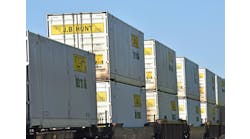Despite Increased Cargo, Port-Proximate Real Estate Demand Cools
Even with the increase in cargo throughput at the top ports year-to-date, port-proximate real estate demand is decreasing, according to report released by Cushman & Wakefield on October 17.
“Through the pandemic, many retailers leased excess space to shore up their supply chains, and now we’re seeing strategies shift back to a just-in-time inventory strategy,” said Jason Price, Americas Head of Logistics & Industrial Research, in a statement. “We expect demand to remain soft in the near term before the market inflects in 2025.”
Compared to the modest totals throughout much of 2023, TEU volumes at key North American ports climbed through the first seven months of 2024, the report noted. Rising import totals were the main driver, as the economy remained resilient despite relatively flat retail sales once adjusted for inflation.
Strong import totals throughout the months leading up to October was the result of the International Longshoremen Association strike, as shippers rushed to bring goods into the U.S. by the Sept. 30 contract expiration. According to Everstream Analytics, while the strike lasted just a few days, it caused a backlog of 54 ships to line up outside the ports across the East and Gulf coasts.
“While import volumes edged higher across key U.S. ports, this has not affected their respective warehouse markets, many of which have experienced limited or negative net absorption since early 2024. However, some port-proximate markets continued to see healthy demand,” said Price.
Houston, Savannah and the Inland Empire industrial markets posted the healthiest absorption totals (9.9 million square feet (msf), 7.3 msf, and 2.8 msf, respectively) through the first half of 2024, driven primarily by new construction deliveries with tenants in place.
Industrial rental rate growth has moderated across port markets, with most West Coast ports reporting notable year-over-year declines as demand slipped and vacancies climbed.
Although the economy and consumers have remained resilient, the industrial market has continued to cool, recalibrating after the record-breaking pandemic years of 2021 and 2022.
From 2023 through mid-2024, a significant amount of new supply was delivered across the U.S. (856.6 msf) as developers continued to introduce new, Class A supply to the market amid a cooling trend. In that time, deliveries accounted for 4.9% of the second-quarter 2024 U.S. inventory total.
However, the pipeline has now substantially dissipated, down 46% year-over-year. While some port markets, such as Houston, Savannah and the Inland Empire saw robust completion totals over the last six quarters—all exceeding 8% of their current inventory totals—many port markets experienced more modest construction totals. New construction deliveries over the past six quarters remain modest in Los Angeles, Oakland/East Bay, New Jersey and Seattle, accounting for less than 4% of their current inventories.



